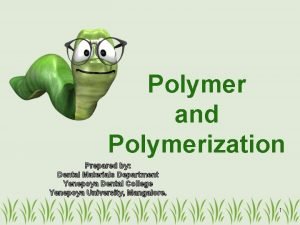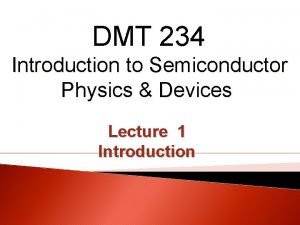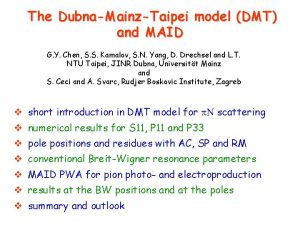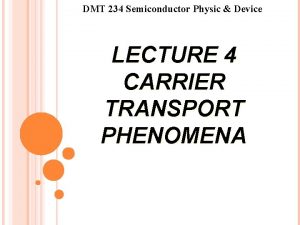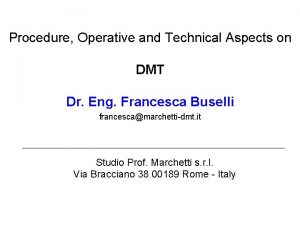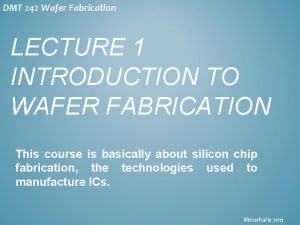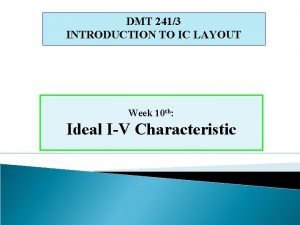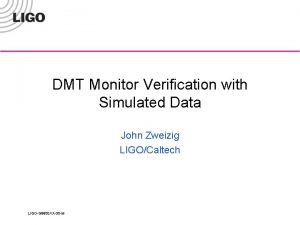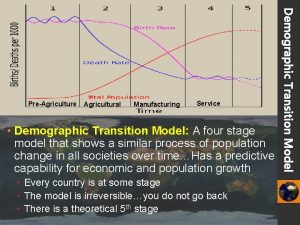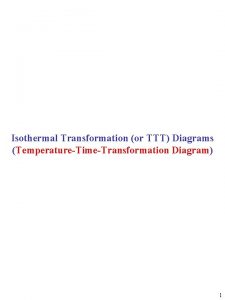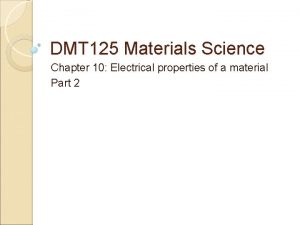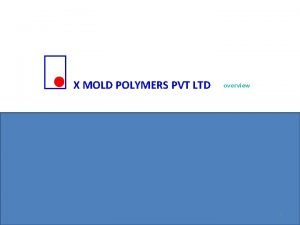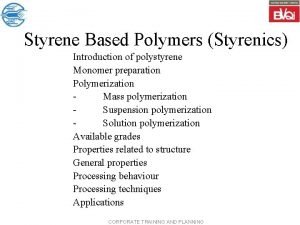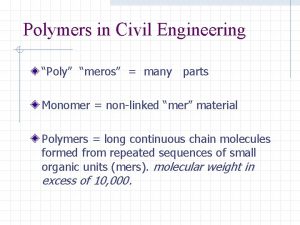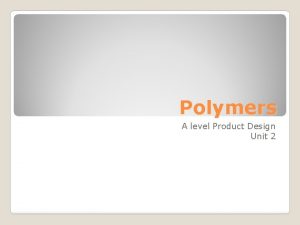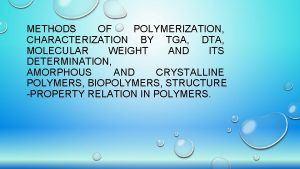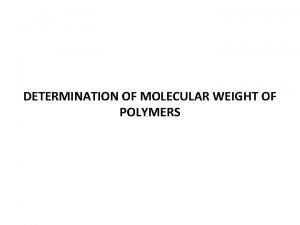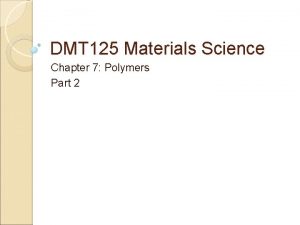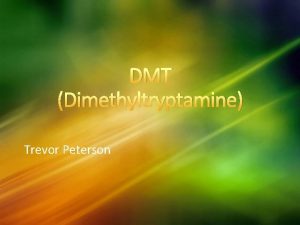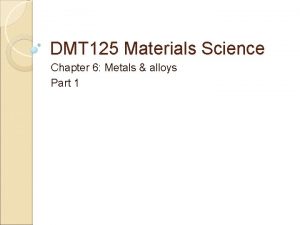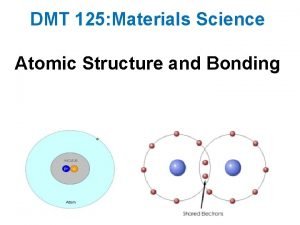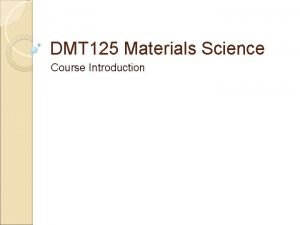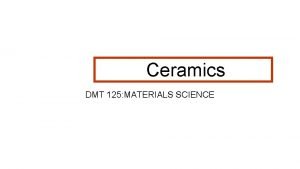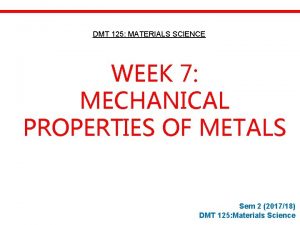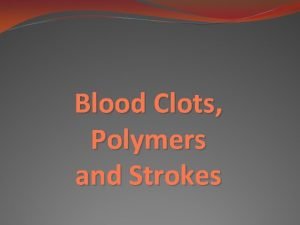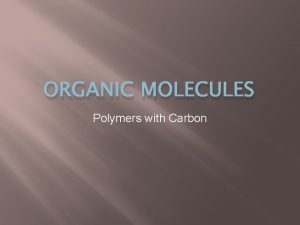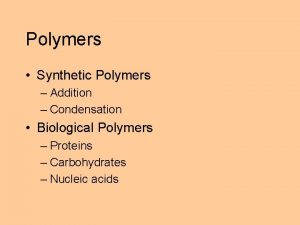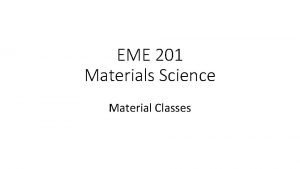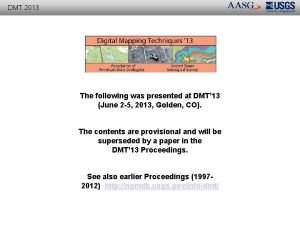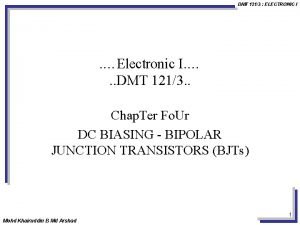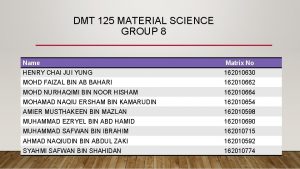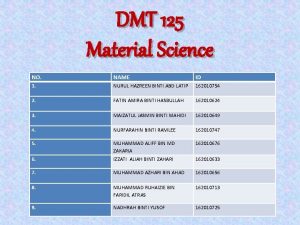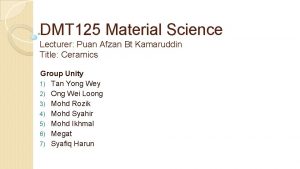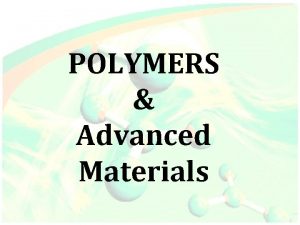DMT 125 Materials Science Chapter 7 Polymers Part



























- Slides: 27

DMT 125 Materials Science Chapter 7: Polymers Part 1

Contents Overview Polymerization reactions Crystallinity & stereoisomerism Thermoplastics Thermosetting plastics (thermosets) Deformation & strengthening Creep & fracture

Overview Polymer means “many parts” Contains many chemically bonded parts or units that themselves are bonded together to form a solid 2 industrial important polymeric materials: ◦ Plastics: large & varied group of synthetic materials that are processed by forming or molding into shape Thermoplastics Thermosetting plastics (thermosets) ◦ Elastomers: can be elastically deformed a large amount when a force is applied to them & can return to their original shape when the force is released

Overview Thermoplastics ◦ Require heat to make them formable & after cooling, retain the shape they were formed into ◦ Can be reheated & reformed into new shapes a number of times without significant change in their properties ◦ Consist of very long main chains of carbon atoms covalently bonded together ◦ Long molecular chains are bonded to each other by secondary bonds

Overview Thermosets ◦ Cannot be remelted & reformed into another shape but degrade or decompose upon being heated too high a temperature ◦ Cannot be recyled ◦ Heat is required to permanently set the plastic ◦ Consist of a network of carbon atoms covalently bonded to form a rigid solid

Overview Advantages ◦ Relatively low in cost ◦ Elimination of parts through engineering design with plastics ◦ Elimination of many finishing operations ◦ Simplified assembly ◦ Weight savings ◦ Noise reduction ◦ Elimination of the need for lubrication of some parts

Polymerization reactions Most thermoplastics are synthesized by the process of chain-growth polymerization Small molecules are covalently bonded together to form very long molecular chains Monomers – simple molecules that are covalently bonded into long chains Polymer – long chain molecule formed from monomer units

Polymerization reactions Ethylene molecule, C 2 H 4 is chemically bonded by a double covalent bond between the carbon atoms & by 4 single covalent bonds between the carbon & hydrogen atoms Chain polymerization – covalently bonded together to form a polymer ◦ Polyethylene – polymer produced by the polymerization of ethylene

Polymerization reactions Mer – repeating subunit in the polymer chain Degree of polymerization (DP) ◦ N in the equation ◦ Number of subunits or mers in the polymer molecular chain ◦ Average – 3500 to 25, 000 corresponding to average molecular masses ranging from 100, 000 to 700, 000 g/mol

Polymerization reactions 3 steps of chain polymerization ◦ initiation ◦ Propagation ◦ Termination Initiation ◦ Free radical – atom that has an unpaired electron that can covalently bond to an unpaired electron of another atom or molecule

Polymerization reactions Example: Hydrogen peroxide, H 2 O 2 ◦ Upon heating, this peroxide can decompose into 2 free radicals ◦ Benzoyl peroxide – organic peroxide used to initiate some chain polymerization reactions Propagation ◦ Process of extending the polymer chain by the successive addition of monomer units Termination ◦ Can occur by the addition of a terminator free radical or when 2 chains combine ◦ Trace amounts if impurities may terminate the polymer chain

Polymerization reactions Thermoplastics consist of chains of polymers of many different lengths, each of which has its own molecular weight & degree of polymerization For a monomer to polymerize, it must have at least 2 active chemical bonds When it has 2 active bonds, it can react with 2 other monomers & by repetition of the bonding, others can form a long chain or linear polymer 3 D network molecules can be built up

Polymerization reactions Functionality – number of active bonds a monomer has Bifunctional – a monomer that uses 2 active bonds for the polymerization of long chains ◦ Example: ethylene Trifunctional – uses 3 active bonds to form a network polymeric material ◦ Example: phenol Bonding between the long molecular chains in polyethylene consists of weak, permanent dipole secondary bonds

Polymerization reactions

Polymerization reactions Homopolymers – polymeric materials that consist of polymer chains made up of single repeating units ◦ Example: AAAAAAA Copolymers – consist of polymer chains made up of 2 or more chemically different repeating units that can be in different sequences

Polymerization reactions 4 ◦ ◦ types Random – randomly arranged within polymer chains AABABBBAAABBB… Alternating – ordered alternation ABABAB… Block – arranged in relatively long blocks of each monomer AAAA---BBBB--Graft – appendages of one type of monomer are grafted to the long chain of another AAAAAAAAA B B

Polymerization reactions

Polymerization reactions Other methods of polymerization ◦ Stepwise Monomers chemically react with each other to produce linear polymers ◦ Network Involving a chemical reactant with more than 2 reaction sites, a 3 D network material can be produced

Crystallinity & stereoisomerism Thermoplastic when solidified from liquid state will form either ◦ Noncrystalline ◦ Partly crystalline solid Noncrystalline ◦ When noncrystalline thermoplastics solidify, there is on sudden decrease in specific volume as the temperature is lowered ◦ The liquid upon solidification, changes to a supercooled liquid that is in the solid state & shows a gradual decrease in specific volume with decreasing temperature

Crystallinity & stereoisomerism Upon cooling this material to lower temperatures, a change in slope of the specific volume versus temperature curve occurs Glass transition temperature, Tg ◦ Average temperature within the narrow temperature range over which slope in the curve changes ◦ Above Tg, viscous behavior is displayed (rubbery) ◦ Below Tg, glass-brittle behavior is displayed (due to molecular chain motion

Crystallinity & stereoisomerism ◦ Tg might be considered a DBT ◦ Example: polypropylene Partly crystalline ◦ When this material solidifies & cool, sudden decrease in specific volume occurs ◦ This is due to more efficient packing of the polymer chains into crystalline regions ◦ As cooling continued, glass transition is encountered ◦ In going through glass transition, supercooled liquid matrix transforms to glassy state ◦ Structure of thermoplastics consists of crystalline regions in a glassy noncrystalline matrix

Crystallinity & stereoisomerism

Crystallinity & stereoisomerism

Crystallinity & stereoisomerism Degree of crystallinity in partly crystalline ranges from 5 to 95 percent of their total volume Complete crystallization is not achievable even with polymeric materials that are highly crystallizable due to: ◦ Molecular entanglements ◦ Crossovers Degree of crystallinity increase,

Crystallinity & stereoisomerism Stereoisomers ◦ Molecular compounds that have the same chemical compositions but different structural arrangements ◦ 3 types: Atactic: pendant methyl group of polypropylene is randomly arranged on either side of the main carbon chain Isotactic: always on the same side of the main carbon chain Syndiotactic: alternates from one side to the other side

Crystallinity & stereoisomerism

END End of Part 1 Copyright © Mr. Mohd. Azarulsani b. Md. Azidin March 2011
 Polymers in dental materials
Polymers in dental materials Device physics
Device physics Dmt 234
Dmt 234 Dmt 234
Dmt 234 Dmt
Dmt Semiconductor
Semiconductor Dmt dynasty models
Dmt dynasty models Dmt
Dmt Dmt fabrication
Dmt fabrication Layout dmt
Layout dmt Dmt monitor
Dmt monitor Population decline
Population decline My favourite subject is science because
My favourite subject is science because Introduction to materials science for engineers chapter 10
Introduction to materials science for engineers chapter 10 Introduction to materials science for engineers chapter 10
Introduction to materials science for engineers chapter 10 Go noodle cant stop the feeling
Go noodle cant stop the feeling Harmful materials and useful materials
Harmful materials and useful materials Man made map
Man made map Adapting and adopting materials
Adapting and adopting materials Direct materials budget with multiple materials
Direct materials budget with multiple materials X mold
X mold Water soluble antiscalant polymers
Water soluble antiscalant polymers Abs plastic
Abs plastic Why do different polymers have different properties?
Why do different polymers have different properties? Meros polymers
Meros polymers Polymers product design
Polymers product design Homochain polymers
Homochain polymers End group analysis
End group analysis
